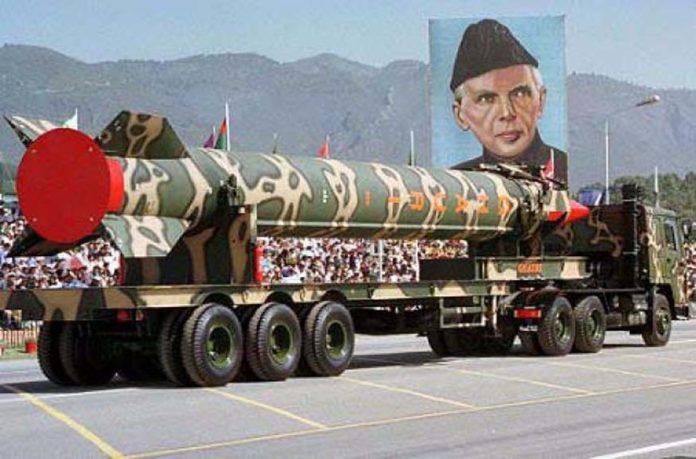Many Pakistanis are thrilled by the news originating from two think tanks in Washington. Although no real evidence has been presented, they claim that the Pakistani nuclear arsenal may become the world’s third largest over the next five to 10 years. The current number, estimated at around 120 Hiroshima-sized warheads, could increase to around 350.
This would exceed numbers held by France (290), China (240), and UK (190).
Is the sky the limit? If not, what is the number that Pakistan “must have”? Seventy years ago, just one bomb had turned Hiroshima to rubble. Today, if Pakistan and India use even half their arsenals, the radioactive ash and smoke would destroy not just both countries but also cause a global catastrophe. Nevertheless, neither specifies a cap. The only figures I have ever seen are speculations published by a retired Pakistani air force officer.
His logic goes something like this: adequate deterrence requires two Indian cities to be hit with five nuclear bombs each. Assume 50pc probability of successfully penetrating enemy defences. Suppose also that 50pc of Pakistan’s nuclear weapons are destroyed in an Indian pre-emptive first strike. Using rules of arithmetic that even a 10-year old knows, he puts the desired number at 40 bombs. Then, changing probabilities from 50pc to 90pc, he raises the cap to a staggering 1,000! For the reader: change two cities to three, and five bombs to six, and calculate the change. It’s huge!
Why this open-ended warhead and missile race between India and Pakistan?
The illogic stares you in the face. Arbitrary input parameters generate arbitrary outputs. And yet all this can be made to appear as the end product of a logical process. But deterrence is purely psychological and nobody has a clue about what is sufficient. Probabilities in a nuclear war environment cannot be properly estimated because the unknown massively outweighs the known. Garbage in, garbage out!
The Indian side is just as guilty of massive leaps of logic. The high priest of India’s nuclear policy in the 1990s, K. Subrahmanyam, vehemently asserted that nuclear arms racing was a Cold War concept totally alien to subcontinental thinking. In the late 1980s and early 1990s he, as well as his hawkish Pakistani counterparts, claimed that the nuclear philosophy of Mutually Assured Destruction (MAD) was the product of twisted Western minds. We, the people of South Asia, were supposedly wiser and would limit destruction only to “what was needed”.
Subrahmanyam and I had first clashed on the subject of India’s nuclear intentions at a meeting held at the University of Chicago in 1992, held to commemorate the 50th anniversary of Enrico Fermi’s nuclear reactor. This was six years before India actually tested. We crossed swords off and on at various meetings for nearly 20 years.
The last time I met this guru of India’s nuclear votaries was just before he died of cancer. This was in Delhi at a meeting held in 2010 at IDSA (Institute of Defence and Strategic Analysis) of which he had been director. I reminded him of his earlier belief that Pakistan could not develop nuclear weapons. Hadn’t he and his colleagues actually weakened India by producing a level playing field? And where was his theory of no racing? Perhaps because of his illness,
Subrahmanyam’s response was weak and unconvincing. But the real reason is that events have proved him wrong.
Like Pakistan, India also refuses to set an upper limit on its arsenal. But why have they gone into open-ended racing when both are saddled with enormous problems of resource scarcity and poverty? A large part of the answer has to do with the nature of modern industrial production.
Imagine setting up a factory that makes jam from peaches. You need to invest in expensive machinery, train management and engineering staff, and set up an acquisition process for raw materials. If you produced only one batch of jam, each jar would probably cost Rs1 million. But when in steady production, that cost could decrease to Rs100.
While the price reduction for warheads is not quite so dramatic, every additional one costs much less than the first one once the machinery, management, and personnel are in place. After routine procedures are established, the system goes on autopilot. The urge to keep production increases because the livelihood of tens of thousands now hinges upon this. There is, of course, a crucial difference. The public buys jam, but the consumer of warheads is the missile-making complex. The system feeds on its own output, and keeps expanding.
To keep everything going, nothing is better than a real threat. Failing that, one needs to be invented. Pakistan’s militarists got lucky in 2010 when India’s former army chief, Gen Deepak Kapoor, blurted out his infamous Operation Cold Start. Although it proved impossible to operationalise, Cold Start provided yet another reason for jacking up Pakistan’s numbers. Now tactical nuclear weapons (TNW) could be developed as a defensive measure. Although much is made of TNWs, in fact they are not very effective militarily — invading frontline combat units can be sufficiently well-hardened and dispersed so as to not make good nuclear targets.
India and Pakistan are seeing the emergence of a nuclear military-industrial complex that is distorting priorities. This term was first used by president Dwight D. Eisenhower in his speech of 1961. He hit the nail on the head when he declared that, “we must guard against the acquisition of unwarranted influence, whether sought or unsought, by the military–industrial complex”. But America’s mad rush towards militarisation became unstoppable. By 1967, the Cold War saw the US warhead count reach a peak of 31,255 — enough to destroy the world four and a half times over.
In the present climate of a tribal blood feud between two nuclear-armed neighbors, vision and judgement have been severely impaired. Since 1998 we have pretended to be two responsible nuclear states. But calling off talks and hurling accusations (as well as artillery shells) exposes this myth. Meanwhile, those who stand to gain more power and influence from nuclear expansion are multiplying in numbers. It is hard to imagine what can restore sanity.







